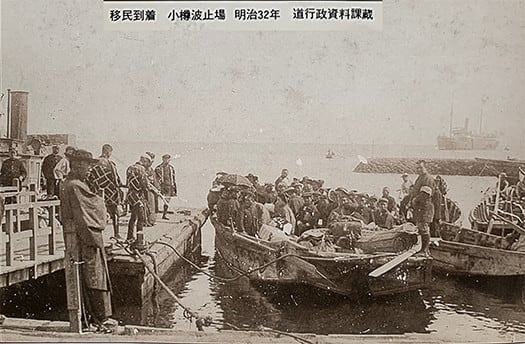
どうもこういう北海道初期の写真には、心が反応してしまって、とらわれてしまう。
わたしの家系は祖父の代の時、大正の初年ころ広島県の福山市周辺地域から一家を挙げて北海道に移住してきた。その事実を物語ってくれる写真などは存在していない。
祖父や祖母からの伝聞でしか、わたしの兄弟たちも情報を持っていない。上の写真はその当時を偲ばせる古写真。わたし自身は祖父や祖母の顔も肉眼では記憶していない。なので、こうした渡道、北海道移住の空気感を肉体感覚としては持っていない。
しかしいま、こうして向き合ってみると言葉がなかなか見つからない。
今日の人間とはまったく違うこの時代の感覚からすれば「先祖伝来の」地を遠く離れて移り住むということに、どういった心事を抱いていたことか。
わたしの父の代の人びとにはふたつの死後の選択がある。それは自分の死後、どこに埋葬されるのか、どう希望するのか、という選択。父の兄弟でも「先祖伝来」の地を選択するのと、北海道に「骨を埋める」という選択をする二者択一。父は祖父の骨の一部とともに北海道に墓を建て、叔父は祖父の遺骨の一部とともに、先祖伝来の地に墓を建てた。
そんなことどもが脳裏をよぎり続けてならない。
一方で、このように移住してきた人びとの内面を想像すれば、まったくの初体験の連続だったのだろう。生まれて初めての長距離移動、それも船での列島縦断だから、すべてが未知の領域の体験。数日間をかけてようやく陸地に上がれる,と言うことの方が即物的心理として大きかったのではないだろうか。
まずはひとごこちが付く、という感覚。時間経過で考えれば、移住のための移動というのは、案外その後の現実対応の方が「アタマのなかがいっぱい」状態で、詠嘆的気分に浸るゆとりはなかったのだろうと思われる。

2枚目の写真では、アメリカの西部開拓同様、入植地での家づくりがさっそくに始められた。北海道開拓使が最初から大きな行政課題としたのが「住宅づくり」であったことと整合的。
アメリカではシロウトでも簡単に家を建てられるように、工法開発が進んでいわゆるツーバイフォー工法が打ち立てられていった。日本ではそもそも開拓使自体が、工法開発するゆとりもないまま、やむなく本土の伝統的工法によって家づくりがされていった。
アメリカがかなり工法開発に時間を掛けて取り組めたのは、「新天地」を求めるという前向きなヨーロッパからの移民の心理が大きかったし、それに対応する策が十分に練られていたように思う。それに対比して、日本の北海道移民政策は、とくに住宅政策に於いて不十分だったと思える。
まずは対ロシアの国防での殖民が喫緊の課題だったことが大きいだろう。
English version⬇
A mere 120 years ago, a mere shadow of the time of the settlement of Hokkaido.
In Japanese society, where the concept of "ancestral land" is strongly rooted, there is a psychological lamentation at the thought of leaving the land. Contrast this with the development of the American West. The contrast with the settling of the western United States.
I am fascinated by these early photographs of Hokkaido, and I am captivated by them.
My family immigrated to Hokkaido from the Fukuyama area of Hiroshima Prefecture in the early years of the Taisho era (1912-1926) during my grandfather's generation. There are no photographs or other evidence of this fact.
The photo above is an old photo that reminds us of that time. My siblings and I have only hearsay from our grandfather and grandmother. I myself do not remember the faces of my grandfather and grandmother with my own eyes. Therefore, I do not have a physical sense of the atmosphere of this migration to Hokkaido.
However, now that I face them, I find it difficult to find words to describe them.
I can only imagine what it must have been like to move far away from the land of one's "ancestors" in a time when people were completely different from those of today.
People of my father's generation seem to have had two choices after death. One is where they would like to be buried after their death, and the other is how they would like to be buried. Even my father's siblings have two choices: they can choose the place of their "ancestors" or they can choose to "bury their bones" in Hokkaido. My father built a grave in Hokkaido with some of my grandfather's bones, and my uncle built a grave in his ancestral place with some of my grandfather's bones.
These thoughts keep haunting my mind.
On the other hand, if one imagines what it must have been like for the people who moved here, it must have been a series of completely new experiences for them. For the first time in their lives, they had to travel long distances across the archipelago by boat, so everything they experienced was in uncharted territory. The fact that they could finally reach land after several days of travel must have been a more immediate psychological experience for them.
First of all, the feeling of being at home. If we think about it in terms of the passage of time, the move for emigration was, surprisingly, more like a "head-full" response to the reality of the situation, and we may not have fallen into the mood of lamentation.
In the second photo, the building of houses in the settlements began immediately, similar to the settling of the western part of the United States. This is consistent with the fact that the Hokkaido Settlement Administration's major administrative task from the beginning was to build houses.
In the U.S., the so-called "two-by-four" construction method was developed so that even a novice could easily build a house. In Japan, the pioneers themselves had no time to develop construction methods and were forced to build houses using the traditional construction methods of the mainland.
The reason why the U.S. was able to take the time to develop construction methods was largely due to the positive attitude of European immigrants seeking a "new land," and it seems that the U.S. had well-developed measures to deal with this situation. In contrast, Japan's Hokkaido immigration policy seems to have been inadequate, especially in terms of housing policy.
First of all, the urgent issue of colonization for national defense against Russia was probably a major factor.



















